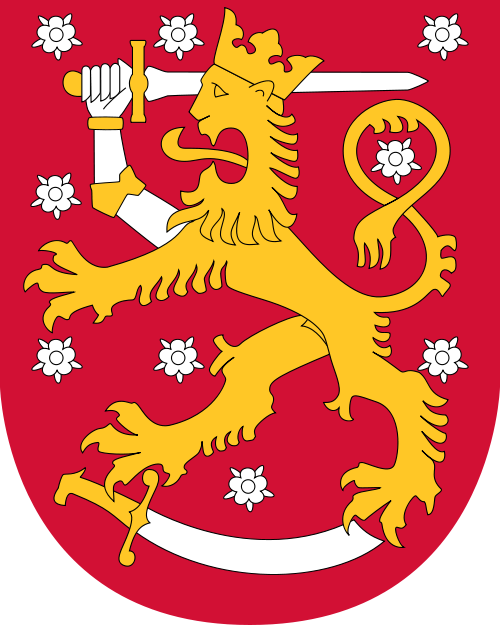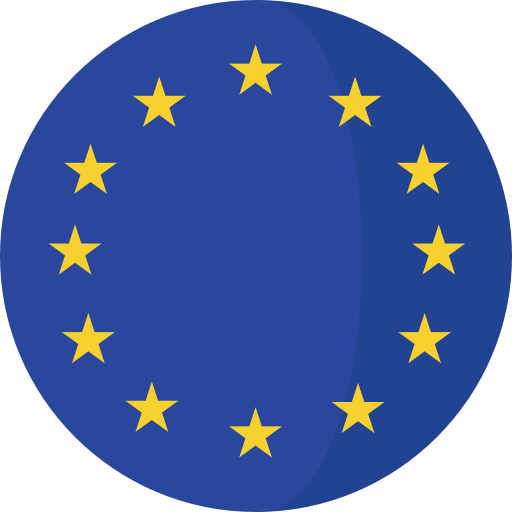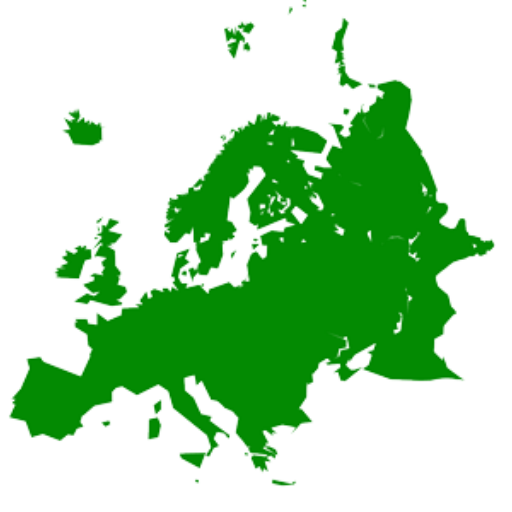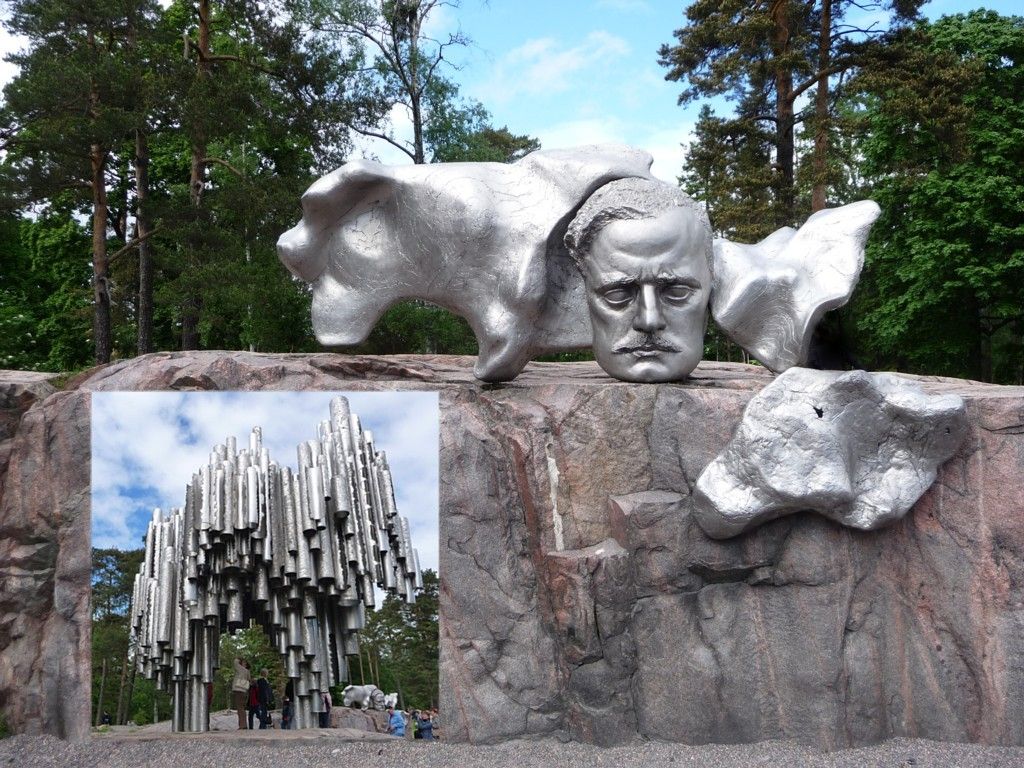

Finnland (finnisch [ˈsuɔmi], schwedisch Finland [ˈfɪnland]), amtlich Republik Finnland (finnisch Suomen tasavalta, schwedisch Republiken Finland) ist eine parlamentarische Republik in Nordeuropa und seit 1995 Mitglied der Europäischen Union. Finnland grenzt an Schweden, Norwegen, Russland und die Ostsee.
Mit etwa 5,5 Millionen Einwohnern auf einer Fläche fast so groß wie Deutschland gehört Finnland zu den am dünnsten besiedelten Ländern Europas. Der Großteil der Bevölkerung lebt im Süden des Landes mit der Hauptstadt Helsinki sowie den Großstädten Espoo, Tampere, Vantaa und Turku. Die beiden Amtssprachen sind Finnisch und Schwedisch, wobei 88,7 % der Bevölkerung finnisch- und 5,3 % schwedischsprachig sind. Die schwedischsprachige Inselgruppe Åland hat einen weitreichenden Autonomiestatus.
Seit dem Ende der letzten Kaltzeit ist in Finnland Besiedlung nachweisbar. Ab der Völkerwanderungszeit kam Finnland über den sich ausweitenden Ostseehandel stärker in Kontakt mit dem übrigen Europa; im Hochmittelalter wurde es christianisiert. Über Jahrhunderte hinweg war Finnland integraler Teil Schwedens, bevor es im 18. Jahrhundert zunehmend in den Einflussbereich des expandierenden Russischen Kaiserreiches geriet und ihm 1809 als Großfürstentum Finnland eingegliedert wurde. Mit der Einführung des Frauenwahlrechts 1906 war Finnland das erste Land in Europa, in dem das aktive Frauenwahlrecht auf nationaler Ebene eingeführt wurde, und weltweit war es nach Neuseeland und Australien der dritte Staat. Beim passiven Wahlrecht ist Finnlands Spitzenstellung noch deutlicher: Erstmals weltweit wurden Frauen in ein Parlament gewählt.
Erst der Sturz des russischen Kaisers und die anschließende Oktoberrevolution 1917 ermöglichten Finnland die Loslösung von Russland. Am 6. Dezember 1917 wurde vom finnischen Parlament die Unabhängigkeit erklärt.
芬兰共和国(芬兰语:Suomen tasavalta,瑞典语:Republiken Finland),通称“芬兰”(芬兰语:Suomi,瑞典语:Finland,![]() 双语发音 帮助·信息),是北欧国家,也是个双语国家,瑞典语和芬兰语平等成为芬兰官方语言。陆地上与瑞典、挪威和俄罗斯接壤,西南面被波罗的海环绕,东南部为芬兰湾,西面则为波的尼亚湾。芬兰是世界高度的发达国家和福利国家,国民享有极高标准的生活品质。联合国公布的《世界幸福感报告》中芬兰在2018至2020年连续三年排为世界上最幸福的国家[8][9][10]。
双语发音 帮助·信息),是北欧国家,也是个双语国家,瑞典语和芬兰语平等成为芬兰官方语言。陆地上与瑞典、挪威和俄罗斯接壤,西南面被波罗的海环绕,东南部为芬兰湾,西面则为波的尼亚湾。芬兰是世界高度的发达国家和福利国家,国民享有极高标准的生活品质。联合国公布的《世界幸福感报告》中芬兰在2018至2020年连续三年排为世界上最幸福的国家[8][9][10]。
フィンランド共和国(フィンランドきょうわこく、フィンランド語: Suomen tasavalta、スウェーデン語: Republiken Finland)、通称フィンランドは、北ヨーロッパに位置する共和制国家。北欧諸国のひとつであり、西はスウェーデン、北はノルウェー、東はロシアと隣接し、南はフィンランド湾を挟んでエストニアが位置している。
首都ヘルシンキは露仏同盟以来、ロシアの主要都市であるサンクトペテルブルク方面へ西側諸国が投資や往来をするための前線基地となってきた。同じく直近の旧領ヴィボルグはサイマー運河の出口であったが、現在はロシア領で、ノルド・ストリームの経由地となっている。ロシアと欧州諸国の間にある地政学的な重要性から、たびたび勢力争いの舞台や戦場になってきた。
中立的外交の裏では、外交・安全保障やエネルギー政策を巡り東西の綱引きが行われている。国内には原子力発電所があり、オンカロ処分場が2020年に開設されれば世界初の使用済み核燃料の最終処分場となる。情報産業も政治と関係しており、公職経歴者が民間企業の幹部になる例として、エスコ・アホという首相経験者がノキア取締役を務めているようなことがある。
人口や経済規模は小さいが、一人当たりGDPなどを見ると豊かで自由な民主主義国として知られている。フィンランドは2014年のOECDレビューにおいて「世界でもっとも競争的であり、かつ市民は人生に満足している国のひとつである」と報告された[1]。フィンランドは収入、雇用と所得、住居、ワークライフバランス、保健状態、教育と技能、社会的結びつき、市民契約、環境の質、個人の安全、主観的幸福の各評価において、すべての点でOECD加盟国平均を上回っている[1]。
Finland (Finnish: Suomi [ˈsuo̯mi] (![]() listen); Swedish: Finland [ˈfɪ̌nland] (
listen); Swedish: Finland [ˈfɪ̌nland] (![]() listen), Finland Swedish: [ˈfinlɑnd]), officially the Republic of Finland (Finnish: Suomen tasavalta, Swedish: Republiken Finland (
listen), Finland Swedish: [ˈfinlɑnd]), officially the Republic of Finland (Finnish: Suomen tasavalta, Swedish: Republiken Finland (![]() listen to all)),[note 1] is a Nordic country in Northern Europe bordering the Baltic Sea, Gulf of Bothnia, and Gulf of Finland, between Sweden to the west, Russia to the east, Estonia to the south, and north-eastern Norway to the north. The capital and largest city is Helsinki. Other major cities are Espoo, Tampere, Vantaa, Oulu, Turku, Jyväskylä, Lahti and Kuopio.
listen to all)),[note 1] is a Nordic country in Northern Europe bordering the Baltic Sea, Gulf of Bothnia, and Gulf of Finland, between Sweden to the west, Russia to the east, Estonia to the south, and north-eastern Norway to the north. The capital and largest city is Helsinki. Other major cities are Espoo, Tampere, Vantaa, Oulu, Turku, Jyväskylä, Lahti and Kuopio.
Finland's population is 5.53 million as of March 2020,[7] the majority of whom live in the central and south of the country and speak Finnish, a Finnic language from the Uralic language family, unrelated to the Scandinavian languages.[8] Finland is the eighth-largest country in Europe and the most sparsely populated country in the European Union. It is a parliamentary republic of 310 municipalities,[9] and includes an autonomous region, the Åland Islands. Over 1.4 million people live in the Greater Helsinki metropolitan area, which produces one third of the country's GDP. Swedish is the second official language of Finland, which is mainly spoken in certain coastal areas and on Åland. A large majority of Finns are members of the Evangelical Lutheran Church.[10]
Finland was inhabited when the last ice age ended, approximately 9000 BC.[11] Comb Ceramic culture introduced pottery 5200 BC and Corded Ware culture coincided with the start of agriculture between 3000 and 2500 BC. The Bronze Age and Iron Age were characterised by extensive contacts with other cultures in the Fennoscandian and Baltic regions. At the time Finland had three main cultural areas – Southwest Finland, Tavastia and Karelia.[12] From the late 13th century, Finland gradually became an integral part of Sweden through the Northern Crusades and the Swedish part-colonisation of coastal Finland, a legacy reflected in the prevalence of the Swedish language and its official status.
In 1809, Finland was incorporated into the Russian Empire as the autonomous Grand Duchy of Finland. In 1906, Finland became the first European state to grant all adult citizens the right to vote, and the first in the world to give all adult citizens the right to run for public office.[13][14] Following the 1917 Russian Revolution, Finland declared itself independent. In 1918, the fledgling state was divided by civil war, with the Bolshevik-leaning Red Guard, supported by Soviet Russia, fighting the White Guard, supported by the German Empire. After a brief attempt to establish a kingdom, the country became a republic. During World War II, Finland fought the Soviet Union in the Winter War and the Continuation War and lost some land, but maintained independence.
Finland remained largely an agrarian country until the 1950s. After World War II, the war reparations demanded by the Soviet Union forced Finland to industrialise. The country rapidly developed an advanced economy while building an extensive welfare state based on the Nordic model, resulting in widespread prosperity and a high per capita income.[15] Finland is a top performer in numerous metrics of national performance, including education, economic competitiveness, civil liberties, quality of life, and human development.[16][17][18][19] In 2015, Finland was ranked first in the World Human Capital[20] and the Press Freedom Index and as the most stable country in the world during 2011–2016 in the Fragile States Index,[21] and second in the Global Gender Gap Report.[22] It also ranked first on the World Happiness Report report for 2018 and 2019.[23]
Finland joined the United Nations in 1955 and adopted an official policy of neutrality. The Finno-Soviet Treaty of 1948 gave the Soviet Union some leverage in Finnish domestic politics during the Cold War. Finland joined the OECD in 1969, the NATO Partnership for Peace in 1994,[24] the European Union in 1995, the Euro-Atlantic Partnership Council in 1997,[24] and the Eurozone at its inception in 1999.
La Finlande (en finnois : Suomi Prononciation ; en suédois : Finland), en forme longue la république de Finlande (en finnois : Suomen tasavalta ; en suédois : Republiken Finland), est un pays d'Europe du Nord, membre de l'Union européenne depuis 1995.
La Finlande est baignée par la mer Baltique, plus précisément par le golfe de Finlande au sud et par le golfe de Botnie à l'ouest et au sud-ouest. Son territoire s'étend de part et d'autre du cercle arctique dans la partie orientale de la Fennoscandie, ce qui fait d'elle un pays nordique entièrement extérieur à la Scandinavie. Composé de plus de 3 000 lacs et d'innombrables îles, parmi lesquelles celles de l'archipel autonome d'Åland, il occupe une superficie totale de 338 145 km2 entre la Norvège au nord, la Russie à l'est et la Suède au nord-nord-ouest, ce qui en fait un des plus vastes pays de l'Union européenne.
Cet espace géographique soumis à un climat rigoureux pendant l'hiver est majoritairement une zone de taïga. Les 5,3 millions d'habitants que recense la démographie nationale confèrent au pays l'une des plus faibles densités de population de toute l'Union européenne. Principalement installés dans le Sud du pays, en particulier sur la côte méridionale, où se trouve la capitale, Helsinki, mais aussi les autres municipalités les plus peuplées, à savoir Espoo et Vantaa, qui sont regroupées au sein de la Région capitale ou Grand Helsinki, les Finlandais disposent de deux langues officielles, le finnois et le suédois.
Enrichie par les apports ancestraux d'une mythologie féconde, par les Samis, ou encore par les populations autochtones de la province septentrionale de Laponie, et bien qu'elle se soit clairement occidentalisée dans la seconde moitié du XXe siècle à la suite d'une reconversion réussie de son économie (centrée sur la sylviculture, puis la métallurgie, et enfin l'électronique), la culture nationale plébiscite toujours un certain dépouillement matériel, dont le sisu et le sauna sont des symboles sûrs, ainsi qu'une culture du silence.
Longtemps sous domination du voisin suédois, sous le règne duquel fut fondée la première capitale, Turku, la Finlande demeure marquée par les nombreux conflits qui l'ont opposée durant toute son histoire récente à la Russie, puissance impérialiste dont elle est devenue un grand-duché autonome en 1809, et dont elle n'a obtenu son indépendance qu'en 1917. L'année suivante, une guerre civile ensanglante le pays, suivie de deux guerres contre l'URSS pendant la Seconde Guerre mondiale, et enfin, d'une longue tutelle soviétique indirecte durant la guerre froide, connue sous le nom de « finlandisation ».
Ces soubresauts n'ont cependant pas empêché l'établissement d'une république stable dont les réalisations sont souvent présentées en modèles, et ce en de nombreux domaines, notamment environnement et qualité de vie. La politique nationale s'articule autour d'un président de la République, Sauli Niinistö, d'un parlement unicaméral, l'Eduskunta et d'un gouvernement dirigé par la Première ministre, actuellement Sanna Marin. Le Grand-duché de Finlande, alors composante de l'Empire russe, a été le premier État en Europe à accorder le droit de vote aux femmes ainsi que le premier au monde à les rendre éligibles au même titre que les hommes. En 2009, l'étude Legatum Prosperity classe la Finlande en première position à la suite de ses performances économiques et de la qualité de vie4.
La Finlande connaît une forte période de récession à la fin des années 2000, en partie liée à l’affaiblissement de son industrie électronique (comme la chute de Nokia), la récession de son voisin russe et une crise dans l'industrie forestière. L'économie du pays se redresse néanmoins au milieu des années 2010.
La Finlandia (in finlandese: , in svedese: ), ufficialmente Repubblica di Finlandia (in finlandese: Suomen tasavalta e in svedese: Republiken Finland)[7], è un paese dell'Europa del nord, facente parte della regione nota come Fennoscandia e della penisola scandinava. Confina con la Svezia a ovest, la Norvegia a nord e la Russia ad est. Si affaccia a sud sul golfo di Finlandia, sulla cui sponda meridionale si trova l'Estonia. È uno Stato facente parte dell'Unione europea.
In Finlandia vivono 5,5 milioni di persone, per la maggior parte concentrate nelle regioni meridionali. In termini di superficie, è l'ottavo stato più grande d'Europa e lo stato con più bassa densità di popolazione nell'Unione europea. Politicamente, è una repubblica parlamentare con un governo centrale con sede nella capitale Helsinki, i governi locali in 336 comuni e una regione autonoma, le isole Åland. Circa un milione di abitanti vive nella zona della conurbazione di Helsinki (composta da Helsinki, Espoo, Kauniainen e Vantaa) e un terzo del prodotto interno lordo del paese è prodotto lì. Altre grandi città sono Tampere, Turku, Oulu, Jyväskylä, Lahti e Kuopio.
La Finlandia fece parte del Regno di Svezia dal XII secolo al 1809, quando divenne un granducato autonomo all'interno dell'Impero Russo fino alla rivoluzione del 1917. Il 6 dicembre di quell'anno la Finlandia ottenne l'indipendenza, seguita da una guerra civile terminata con la sconfitta dei "Rossi" filo-bolscevichi da parte dei filo-conservatori "Bianchi" sostenuti dall'Impero tedesco. Dopo un breve tentativo di stabilire una monarchia nello stato, la Finlandia divenne una repubblica.
L'esperienza finlandese della Seconda guerra mondiale ha coinvolto tre conflitti separati: la Guerra d'inverno (1939-1940) e la Guerra di continuazione (1941-1944) contro l'Unione Sovietica, e la Guerra di Lapponia (1944-1945) contro la Germania nazista. Dopo la fine della guerra, la Finlandia ha aderito all'Organizzazione delle Nazioni Unite (ONU) nel 1955, all'Organizzazione per la cooperazione e lo sviluppo economico (OCSE) nel 1969, all'Unione europea nel 1995 e alla zona Euro fin dal suo inizio nel 1999. Durante questo tempo, ha costruito uno stato sociale vasto in stile nordico.
La Finlandia era in ritardo rispetto all'industrializzazione, rimanendo uno stato in gran parte agricolo fino al luglio del 1949. Successivamente, lo sviluppo economico è stato rapido, tale che con un reddito pro-capite nominale di oltre 49 000 dollari statunitensi, la Finlandia è uno degli stati più ricchi del mondo. Secondo alcune misure, la Finlandia ha il miglior sistema educativo in Europa ed è stata classificata come uno degli stati più pacifici ed economicamente competitivi del mondo. È stata anche classificata come uno degli stati al mondo con la più alta qualità della vita. Secondo la rivista Newsweek la Finlandia è "il miglior stato del mondo".[8]
Finlandia, oficialmente República de Finlandia (en finés: ![]() Suomi (?·i) o Suomen Tasavalta; en sueco: Finland o Republiken Finland), es un país miembro de la Unión Europea desde 1995 y situado en el noreste de Europa. Tiene fronteras al oeste con Suecia, al este con Rusia y al norte con Noruega. Por el oeste y el sur está rodeada por el mar Báltico, que la separa de Suecia y Estonia, cruzando los golfos de Botnia y Finlandia, respectivamente. La capital y ciudad más importante del país es Helsinki.
Suomi (?·i) o Suomen Tasavalta; en sueco: Finland o Republiken Finland), es un país miembro de la Unión Europea desde 1995 y situado en el noreste de Europa. Tiene fronteras al oeste con Suecia, al este con Rusia y al norte con Noruega. Por el oeste y el sur está rodeada por el mar Báltico, que la separa de Suecia y Estonia, cruzando los golfos de Botnia y Finlandia, respectivamente. La capital y ciudad más importante del país es Helsinki.
En 2017, Finlandia contaba con una población de 5,5 millones de habitantes en un área de 338 145 km².3 La gran mayoría de la población del país se concentra en el extremo sur, en la costa del golfo de Finlandia y sus alrededores (incluyendo el Área Metropolitana de Helsinki). Finlandia es el sexto país más extenso de Europa y cuenta con una densidad poblacional baja de 16 habitantes por km², lo que le convierte en el menos densamente poblado de la Unión Europea. La mayoría de los finlandeses hablan finés (o finlandés) como su lengua materna, la cual es una de las pocas lenguas oficiales de la Unión Europea que no descienden de la familia indoeuropea. La segunda lengua oficial de Finlandia es el sueco, hablado como lengua materna por el 5,6% de la población.4
Finlandia fue parte de Suecia hasta que en 1809 fue anexionada por el Imperio ruso, pasando a ser el gran ducado de Finlandia (entidad autónoma de Rusia hasta 1917, cuando obtuvo la independencia). Actualmente, Finlandia es una república parlamentaria y democrática, y es miembro de las Naciones Unidas desde 1955, así como de la Unión Europea desde 1995. La economía finlandesa es una de las más prósperas de Europa, basándose en los importantes sectores de servicios, así como de manufactura. En el país existe un estado del bienestar, así como una política altamente democrática y con niveles sumamente bajos de corrupción.
Финля́ндия (фин. Suomi, швед. Finland, произношение на обоих языках ; официально — Финля́ндская Респу́блика, фин. Suomen tasavalta, швед. Republiken Finland[5]) — государство в Северной Европе.
Население (оценка 2017 года) — 5 560 000 человек, площадь территории — 338 430,53 км². Занимает 114-е место по количеству населения и 64-е по территории в мире.
Столица и крупнейший город — Хельсинки.
Государственные языки — финский и шведский. Частота использования жителями Финляндии того или иного государственного языка варьируется на разных территориях (например, на Аландских островах в качестве официального языка используется лишь шведский, а на севере страны и вовсе преобладают саамские языки).
Парламентская республика. С 5 февраля 2012 года пост президента занимает Саули Нийнистё.
С 6 декабря 1917 года является независимым государством (2017 год объявлен годом








 Geography
Geography
 States of Europe
States of Europe





